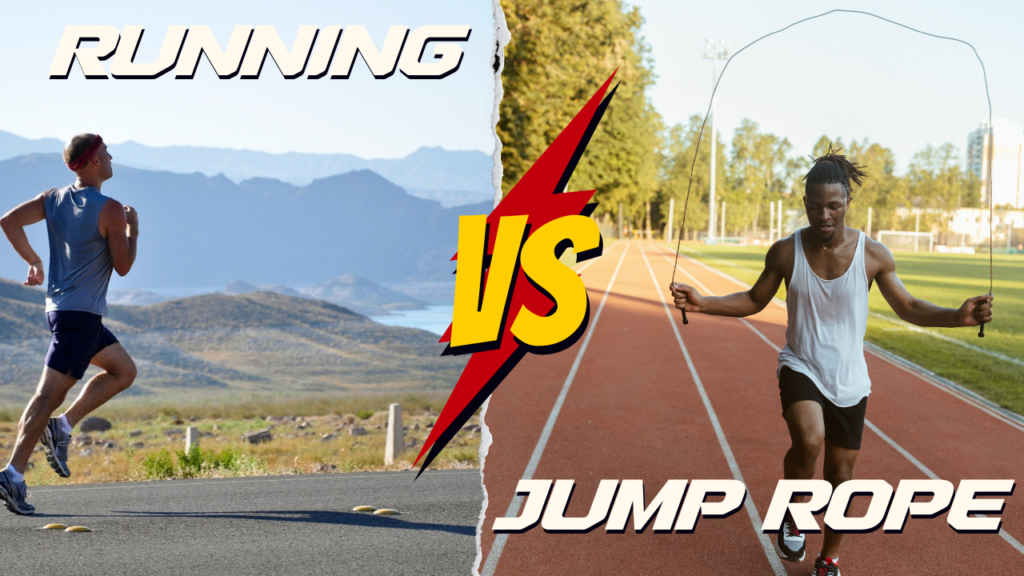Time is valuable. If there is a faster, better way to do something, it’s usually in your best interest to take it.
If you want to lose weight, most people will tell you to run to burn calories. But is running the most effective use of your time?
Another effective way is to burn calories by jumping rope. Boxers do it and boxers are fit, right? Remember Rocky?

So, is jumping rope more effective than running?
Sorry to disappoint you with a complicated answer to a simple question but “it depends.”
Running and Jumping Rope – Impact and joint strength
Both running and jumping rope are higher impact than something like rowing or swimming. Meaning, they cause more stress on your joints because they involve continually landing on your feet propelled by the weight of your body.
The heavier you are or the higher you jump, the more impact you generate. Over time, this impact can cause your joints to strain and can lead to injury.
It’s important that whatever exercise you choose, you pay attention to form and to minimizing the impact force to joints.
If you’re running, this means running with proper form – proper cadence, stride length, foot placement, and upper body positioning.
Your body is a kinetic chain. Any less than optimal form will result in a break and lead to injury.
Check out this video by Olympic Qualifying Marathon runner Sage Canaday
If you’re jumping rope, it’s important to pay attention to how your feet land and the role of your knees.
Try to minimize the space between yourself and the ground by jumping roughly 1-2 inches off the ground.
Also, keep your toes pointed down slightly and avoid pulling your feet back or tucking your knees.
Lastly, always have a slight bend in your knees and land softly on the balls of your feet to dissipate the stresses from jumping throughout your body.
You’ll also want to pay special attention to the surface you jump on. While you need a relatively hard surface to successfully jump rope (sand is not recommended!) a floor with a little give is better than pavement. Try a hardwood floor or hard rubber surface (like gym floor). Even asphalt has a little more give than pavement.
Here’s a quick video by the Jump Rope Dudes on proper jump rope form
At the end of the day, I’d say jumping rope is easier on joints, simply because it involves less of them. The caveat is that this means jumping rope won’t be as effective and flexing and strengthening hip and knee joints as well as running.
Jump Rope vs Running for Muscular Growth
There is some evidence to suggest that jumping rope may be more effective for promoting muscle growth compared to running.
One study published in the Journal of Strength and Conditioning Research found that 12 weeks of jump rope training led to significant increases in muscle mass and strength in the upper and lower body, as well as improvements in cardiovascular fitness, compared to a control group who did not exercise.
Another study published in the Journal of Sports Science and Medicine compared the effects of jump rope training to running and found that jump rope training led to greater increases in muscle mass and strength in the upper body, as well as greater improvements in cardiovascular fitness, compared to running.
Of course, this all depends on intensity as well. A sprinter will develop more muscle than a light jump roping session. You can also increase the difficulty and resistance of a jump rope by using a weighted jump rope, where either the handles, or the rope are weighted. This will cause more fatigue in your shoulder while you hold the rope and in your legs as you jump carrying more weight.
Jump Rope vs Running for Weight Loss
At the end of the day the science behind calorie burning is simple, the more energy you exert, the more calories you burn.
Jumping rope is appealing because we can generally exert more energy in a shorter amount of time – given that we are running at an easy, conversational pace.
If you compare calories burned jumping rope vs running, you’ll likely be comparing apples to oranges. Since you’ll be assuming you can jump rope for as long as you can run.
Jumping rope burns more calories in 30 minutes than running but can you really jump rope for 30 minutes?
Probably not. Your calves might fall off. Especially if you’re just starting.
If you want to calculate jump rope calories, you can use this simple jump rope calorie calculator or get a rough idea with this calorie chart. Courtesy of Rope City.

That’s why High-Intensity Interval Training is popular. HIIT emphasizes shorter, intense bouts of exercise mixed with rest.
You can check out my HIIT Jump Rope routines here: HIIT with Jump Rope.
You can also add variety to your jump rope routines that increase the intensity, such as performing double-unders (where the rope passes under twice in one jump) or modifying the jumping cadence or rhythm.
Jump Rope Vs Running. Fun Factor
Motivation is a big factor in exercise science. You want to do something that’s at least fun to you. Although you may not think running is fun now, there is a reason it is so popular.
Running tends to build communities around it (run clubs, meet-ups, brewery runs). Jumping rope is a one man show thing. You wouldn’t really ask someone to jump rope with you at the beach.
You can run in the mountains, run as transportation and run on different surfaces. A lot of ways to mix it up.
You can keep things on the jump rope interesting too, you just might have to get a little more creative.
There are several creators on YouTube and fitness apps that specialize in coming up with fun and engaging jump rope routines.
Conclusion
I wish there was a better, definitive answer to the question – is jumping rope better than running? – but there isn’t. Different variables come in to play. It all depends on what motivates you and what you’re willing to stick with. If that’s jumping rope – great! If not, no big deal. You may like to weight lift, row, or swim. It doesn’t matter – just stay active!

